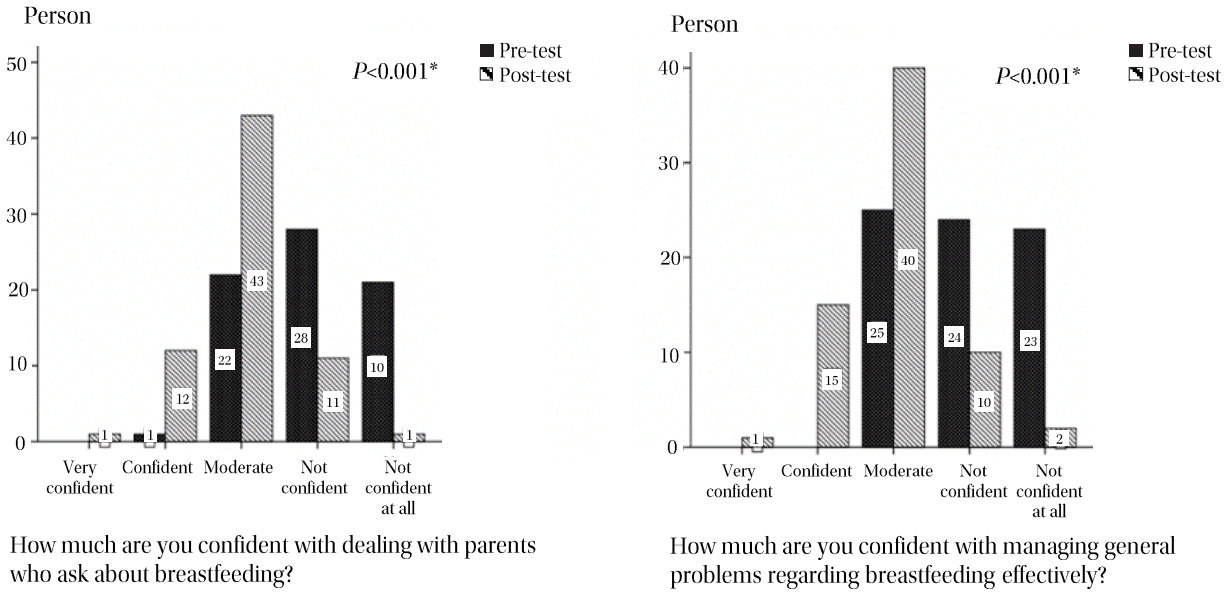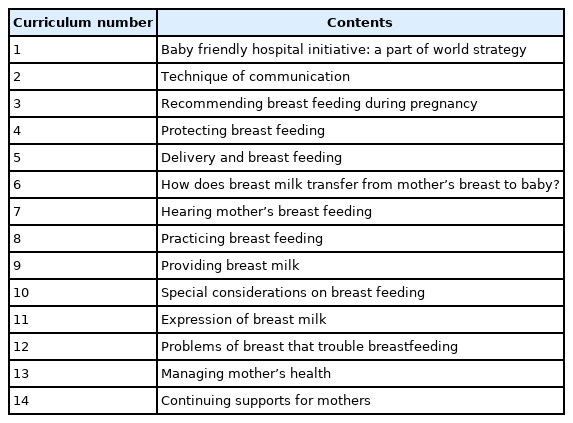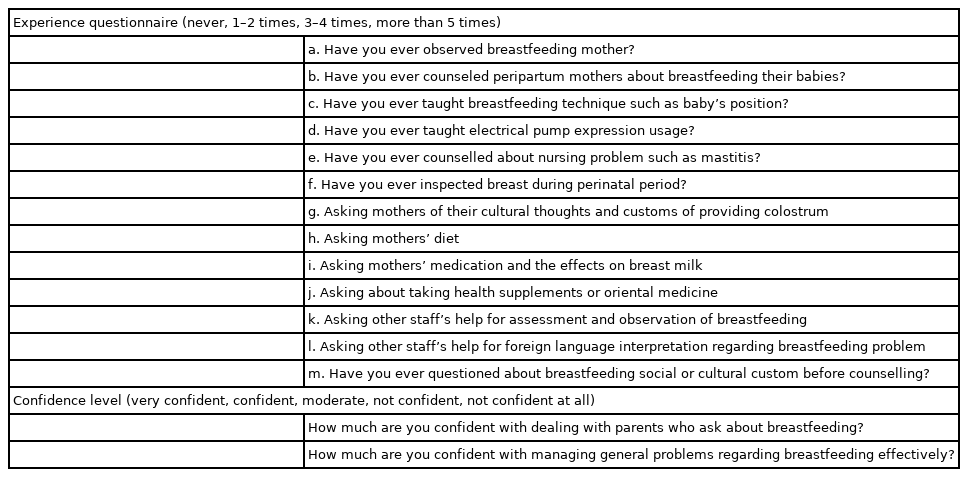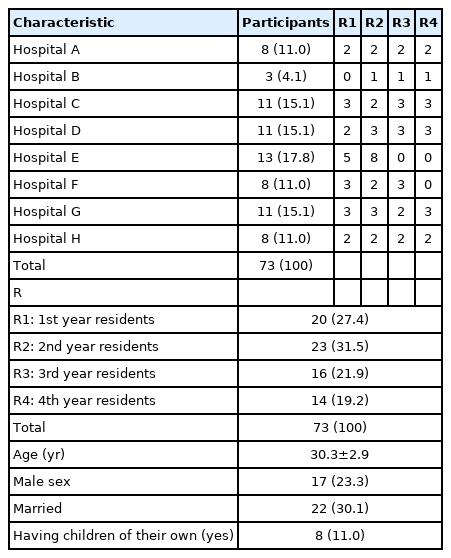A Multi-Center Educational Research Regarding Breastfeeding for Pediatrics Residents in Korea
Article information
Abstract
Purpose
Pediatricians have a significant responsibility to educate mothers about the importance of breastfeeding. However, there have been minimal efforts in the courses of resident training in Korea. The purpose of this study is to evaluate the change in knowledge and attitude before and after a 4-week breastfeeding educational intervention among multicenter residents.
Methods
Prospective interventional educational research was designed for residents at eight training hospitals in Korea. Institutional reviews were obtained in each hospital. The education curriculum consisted of 14 courses regarding breastfeeding theory and practice. These materials were used to teach pediatric residents for 4 weeks. Knowledge-based tests were administered before the course, and re-tests were administered after the course using different test items of similar levels. Test scores and survey responses were compared before and after the intervention.
Results
A total of 73 residents (1st year 20, 2nd year 23, 3rd year 16, and 4th year residents 14) from eight training hospitals completed the intervention. Their average age was 30.3±2.9 years, 17 (23.3%) were male, 22 (30.1%) were married, and eight had more than one child of their own. The mean pre-test score was 61.8±13.4 and the mean post-test score was 78.3±7.5 (P<0.001). The inter-grade difference in the score was significant in the pre-test (P=0.005), but not significant in the post-test (P=0.155). There were more responses of obtaining confidence after the intervention (P<0.001).
Conclusion
In our study, pediatric residents showed improvement in their knowledge and confidence level after 4 weeks of the breastfeeding curriculum. This will provide a basis for future policymaking in the training of pediatric residents regarding breastfeeding in Korea.
서론
모유는 1년 미만의 아기에게 줄 수 있는 가장 완벽한 음식이며, 그 장점에 대해서는 이미 잘 알려져 있다[1]. 그럼에도 불구하고 많은 수유모가 여러 가지 이유로 모유수유를 포기하고 있어, 우리나라의 완전 모유수유율은 매우 저조한 수준이다. 2003년 6개월 완전 모유수유율이 25.3%이었던 것이 이후로 지속적인 감소를 보여 2016년에는 5.6%, 2018년에는 2.3%까지 떨어졌다[2,3].
소아청소년과 전문의는 산부인과 전문의와 더불어 출산 및 신생아 관리에 있어 가장 가까이에서 모유수유에 대한 교육과 지도를 할 수 있는 전문가이며 또한 그러한 의무가 있다고 할 것이다. 2016년에 개정된 대한소아청소년과학회의 전공의 연차별 교과과정을 보면 환자 취급 범위, 교과 내용 학술회의 참석, 학술회의 발표, 논문 제출로 정리되어 있는데[4], 질환군을 치료하는 내용 이외에 육아 상담 및 영유아 검진 경험에 대한 수련 내용을 포함하고 있지만 모유수유에 대한 내용은 아직 담고 있지 않은 실정이다.
따라서 저자들은 현재 우리나라의 소아청소년과 전공의들의 모유수유에 대한 전반적인 지식의 정도, 그리고 수유모들을 대상으로 상담할 때의 구체적인 능력과 자신감에 대해 알아보고 4주 동안의 공동 교과 교육을 시행하여 전후의 변화 양상을 알아보고자 하였다.
대상 및 방법
본 연구는 8개의 수련 병원에 소속된 소아청소년과 전공의들을 대상으로 한 전향적 중재적 관찰 연구이며 각 병원별로 기관심의위원회의 심사 승인을 얻은 후 진행하였다. 연구에 참여한 대상자는 자발적인 참여를 원칙으로 하였고 대상자 동의서를 득하였다. 각 기관의 연구 책임자는 공동으로 공유한 동일한 교육 자료를 통해 해당 기관의 전공의를 대상으로 4주 동안 교과 과정을 강의하였다. 강의는 총 14개의 장으로 구성되었고 7개 기관에서는 신생아분과 전문의가, 1개 기관에서는 소아소화기영양분과 전문의가 진행하였으며, 내용은 Table 1과 같다. 교육 전후로 25 문항의 시험을 실시하였다. 교육 전 시험 문항과 교육 후 시험 문항은 비슷한 수준을 유지하되 서로 다른 문항으로 준비하였다. 25개의 지식 관련 시험 문항 외에 추가로 13 문항의 설문 조사를 통해 모유수유교육에 대한 태도 및 경험에 대해 묻고 자신감에 대한 항목으로 2개를 조사하여 전후를 비교하였다(Table 2).
통계는 SPSS version 19.0 (IBM Co., Armonk, NY, USA)을 사용하였고, 연구 참여자의 전후 성적 비교를 위해서 paired t-test, 전공의 연차 사이에 전후 성적에 차이가 나는지 분석하기 위해서 Kruskal Wallis test를, 그리고 설문 조사의 전후 차이 분석을 위해 Pearson chi-square test를 사용하였으며 유의한 P 값은 0.05 미만으로 하였다.
결과
2019년 7월부터 2019년 12월까지 8개의 병원 73명이 연구를 완료하였다. 기관별로 참여한 대상자 수와 연차별 분포 및 나이, 성별, 그리고 자녀 유무는 Table 3과 같다.
교과 강의를 실시하기 전에 시행한 성적은 전체 73명 평균 61.8–13.4점으로 교육 이수 후에는 78.3–7.5점으로 의미 있는 차이를 보였다(P<0.001). 교육을 실시하기 전에는 연차별로 성적 차이가 있었지만(P=0.005), 교육 후에는 차이가 없었다(P=0.155) (Table 4).
Table 2에 기술한 모유수유 교육과 관련한 경험 설문 결과를 Figure 1에 표시하였다. 경험의 변화를 묻는 13개의 항목 중에서 12개에서는 교육 전후로 의미 있는 차이가 없었다. 그러나, g 항목인 ‘모유수유 권고 시 초유 섭취에 대한 문화적 신념과 관행에 대해 물어 본 적이 있는가?’에 대해서는 교육 전후로 통계적으로 의미 있는 차이가 있었다(P=0.008). ‘모유수유에 대해 질문을 하는 부모에게 얼마나 자신감 있게 대처할 수 있었는가?’, ‘모유수유에 대한 전반적인 문제들을 다루는 데 있어 얼마나 자신감이 있는가?’를 묻는 항목에 대해서는 Figure 2에 표시하였고 두 항목 모두에서 교육 전후로 ‘매우 자신 있다, 자신 있다, 중간 정도이다, 자신이 없다, 전혀 자신이 없다’의 응답 사이에 호전되는 차이를 보였다(P<0.001, P<0.001).

Survey questionnaires comparisons before and after breastfeeding education. There was one significant difference in ‘g’ questionnaire between the course (P=0.008). Chi-square test was used. *Statistically significant.

Confidence survey. There were statistically significant differences in the comparison of confidence before and after the education. Chi-square test was used. *Statistically significant.
마지막으로 ‘모유수유에 관한 이러한 교육이 향후 소아청소년과 전공의 수련 과정에 포함된다면 향후 아기와 수유모를 돌보는 데 영향을 줄 것으로 생각하는가’에 대한 질문에 ‘매우 영향력이 있을 것이다’ 는 13명(19.4%), ‘영향력이 있을 것이다’ 40명(60.0%), ‘중립적’ 14명(20.9%), ‘영향력이 없을 것이다’ 0명(0%), ‘전혀 영향력이 없을 것이다’ 0명(0%) 이었다.
고찰
본 연구에서 저자들은 8개의 병원에서 수련받는 소아청소년과 전공의를 대상으로 모유수유 교육 연구를 계획하고 수행하였다. 이를 통해 한국에서 소아청소년과 전공의 수련 과정 중에서 과연 모유수유에 대한 교육이 충분하다고 볼 수 있는지, 또한 정규 과정으로의 편성에 대해 얼마나 정당성을 확보할 수 있을지를 가늠해 볼 수 있는 하나의 자료를 만들고자 하였다. 우리 연구와 유사하게 전공의, 학생, 혹은 기타 의료진을 대상으로 한 모유수유 관련 교육 연구가 소수 존재하는데, 대부분의 연구에서 지식에 기초한 성적, 의학적 행위 차이가 교육 전후로 명확하게 향상되는 것을 볼 수가 있다[5-7].
본 연구에서도 전체 대상자의 교육 전 시험 점수는 100점 만점에서 61.8–13.4점이었고, 교육 후 점수는 78.3–7.5점으로 전후에 통계적으로 의미 있는 차이를 보였는데(P<0.001), 이는 관련 지식의 향상을 확인하는 것으로서 사전에 충분히 예상할 수 있었던 결과라고 할 수 있다. 흥미로운 것은 교육 전에는 전공의 연차별로 성적에 차이가 나던 것이(P=0.005) 교육 후에는 차이가 나지 않았다는 것이다(P=0.155) (Table 3). 다시 말해서 그동안 모유 수유에 대한 교육이 부족했다는 것을 미루어 짐작할 수 있을 뿐만 아니라, 간단한 교과 교육을 통해서 연차별 지식의 차이를 상쇄하였다는 것을 알 수 있다.
그러나 연구 결과를 통해 알고자 했던 더 중요한 사실은 현재 그들이 접하고 있는 모유 수유 관련 교육의 현실, 그리고 4주간의 교육 후 관련 행동 양상 및 인식이 변화할 수 있는가를 살펴보는 것이었다. Esselmont 등[8]이 2018년에 게재한 연구에서 캐나다의 201명의 전공의를 대상으로 조사한 연구에 따르면, 모유수유에 대한 지식 점수는 평균 71% 정도였으나 단지 4%에서만 모유수유 교육에 대해 ‘매우 편안하게 생각한다’고 대답했고, 모유수유하는 과정을 직접 관찰한 경우는 1/4도 되지 않았다. 우리 연구에서도 전공의들이 지금까지의 수련 과정 중에서 수유모를 대상으로 실제로 지도를 해본 경험에 대해 조사해 보았을 때, 병원에서 모유 수유하는 환자를 관찰한 적이 있는지, 분만 전후의 산모에게 수유 상담을 제공한 적이 있는지, 모유수유에 관한 기술, 유축기 사용법, 유선염, 젖꼭지 갈라짐 등 수유 시 발생할 수 있는 문제점에 대해 상담해 준 적이 있는지, 유방 검진을 해 본 적이 있는지, 수유모의 식이 및 약물 복용에 대해 상담해 준 적이 있는지 등 13개 항목의 전반적인 부분에서 경험이 매우 부진한 것을 볼 수 있었다(Figure 1). 저자들은 본 연구에서 4주 동안의 교육 후에 행동의 변화에 대해 다시 조사하였는데, 일정한 행동의 변화 유도를 확인하기에는 충분한 시간이라고 보기에는 어렵지만, 8개의 설문 조사 항목 대부분에서 긍정적인 변화가 있었으나 통계적 유의성은 없었다. 다만 모유수유 지도를 할 때, ‘초유 섭취에 관한 문화적 신념과 관행에 대해 질문하였는가’의 항목에서는 한번도 해 보지 않았다는 응답이 66명에서 48명으로, 한두 번 해 봤다는 응답은 4명에서 17명으로 변화하는 등 통계적으로 유의한 차이를 보였다(P=0.008). 뿐만 아니라 수유모를 대상으로 하는 모유수유 교육에 대한 자신감에 대해 묻는 2개의 항목에서는 2개 모두 의미 있는 변화를 보였다. 즉, 모유수유에 관한 부모의 질문에 적절히 대처하였는지, 그리고 일반적인 모유수유에 관한 문제를 효과적으로 관리하였는지에 대한 항목에서 각각 P<0.001으로 자신감을 가진 비율이 많아졌다(Figure 2).
현대화된 사회에서 어머니들로 하여금 모유수유를 시작할 수 있도록 하고 지속할 수 있도록 노력해야 하는 요인들로는 여러 가지가 있을 수 있지만, 숙련된 의료인력의 역할이 긍정적인 효과를 주는 것으로 알려져 있다 [9]. Barnes 등[10]의 연구에 의하면 모유수유에 대해 수유모들이 결정을 유보하도록 하는 요인들로는 과거에 모유수유에 어려움을 겪었던 경험이 가장 컸고, 이외에 분유 수유가 보다 편안해 보이거나 신뢰가 느껴져서였다고 보고하였다. Cattaneo와 Buzzetti [11]는 병원 내 종사자들을 대상으로 교육을 하였을 때, 환자들이 퇴원 시에 모유 수유율이 유의하게 증가하였음을 보고한 바 있다. 이는 수유모들의 인식을 바로 잡아 줄 필요가 있고, 이러한 노력에 있어 의료 종사자를 대상으로 교육을 진행하는 것이 효과적인 전략이라고 할 수 있다는 것이다. 모유수유율이 저조한 우리나라에서도 숙련된 의료진의 수유모들에 대한 역할이 매우 중요하다. 특히, 앞으로 수유모와 영아들을 가장 가까이에서 진료하고 지도하게 될 소아청소년과 전공의들이 충분한 교육을 받고 상담에 대한 전문적인 지식을 갖추어야 함은 아무리 강조해도 지나침이 없다.
이러한 모유수유에 대한 전문적인 지식은 상당히 구체적이어야 한다. 미국에서 12주 미만의 아이에게 직접 수유를 하는 수유모를 대상으로 한 설문 연구에 의하면[12], 모유 수유가 불충분하다고 느껴지는 큰 요인으로 수유를 6개월 미만으로만 하고자 계획 세웠던 것, 아기가 보채고 우는 것, 아기가 자주 젖을 찾는 것, 젖물림 어려움 등을 꼽았다. 스페인의 한 흥미로운 연구에 의하면, 수유모들이 완전 모유수유에 실패하는 요인의 하나로 모유수유에 대한 지식을 의학적 전문가로부터가 아니라 일가 친척들로부터 얻는 경우가 오즈비 9.2로 높았다[13]. Park 등[14]에 의하면 현재 임신 여부가 모유수유 교육에 대한 요구도를 높이는 데 영향을 주는 인자임을 보여주고 있고 특히 임신성 당뇨에서 체질량 지수가 높은 고위험일수록 요구도가 높은 것을 보여 주었다. Lee 등[15]은 성공적인 모유수유를 위해 잘 짜여진 인터넷 기반의 교육이 필요함을 피력하였다. 따라서 산모 및 수유모를 대상으로 제대로 된 교육을 함으로써 그들의 행동에 변화를 일으키도록 해야 할 것이다. 소아청소년과 전공의뿐만 아니라 모유수유에 대해 지도할 수 있는 능력을 갖추어야 할 인력으로는 산부인과 전문의, 의대생들도 포함되어야 한다[16,17]. 그러나 한국에서 심지어 소아청소년과 전공의에 대한 교육도 충분하지 않은 것을 알 수 있었다. 미국의 연구[18]에서처럼 우리나라에서도 향후 소아청소년과 전공의 수련 과정에 모유수유에 대한 과정을 강조할 필요가 있다.
본 연구는 다음과 같은 제한점이 있다. 첫째, 8개의 다기관을 포함하였음에도 대상자 수가 충분하지 않아 전공의 연차별로의 분석이 용이하지 않았다. 둘째, 교육 자료를 공통으로 공유하기는 하였으나, 기관마다 교육자들이 동일하지 않은 약점이 있다. 셋째 교육 기간을 4주로 정하였지만, 강의 시간에 대해 동일한 지침을 가지지 않았다. 그러나 한국에서 최초로 전공의를 대상으로 하는 모유수유 교육에 대한 전향적 다기관 교육 중재 연구를 수행했다는 점에서 의의가 있다.
저자들은 8개의 소아청소년과 수련 병원에서 총 73명의 1–4년차 전공의를 대상으로 4주간의 모유수유 교육을 실시하였고, 교육 전후로 관련 지식에 대한 성적의 향상을 보았다. 또한 아기의 부모로부터 모유 수유에 대한 질문에 대처하고, 전반적인 모유수유 문제를 관리하는 데 있어 자신감의 향상을 보였다. 이에 소아청소년 수련교육 과정으로 체계적인 모유수유 교육을 포함시킬 것을 강력히 추천하는 바이다.
Notes
Ethical statement
This study was approved by the Institutional Review Board committees of Asan Medical Center (2019-0583) and Kyung Hee University Hospital (KHUH 2019-07-074-003). Informed consents were obtained from all the participating residents.
Conflicts of interest
No potential conflict of interest relevant to this article was reported.
Author contributions
Conception or design: Y.S.C., E.A.R.K.
Acquisition, analysis, or interpretation of data: Y.S.C., S.H.C., E.S.K., E.H.L., E.J., S.Y.L., W.L., H.S.Y., Y.J.K., J.K.P., S.M.S., E.A.R.K.
Drafting the work or revising: Y.S.C.
Final approval of the manuscript: All authors read and approved the final manuscript.
Funding
None
Acknowledgements
None




